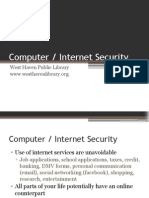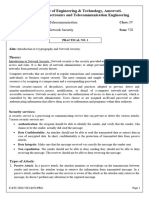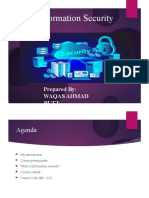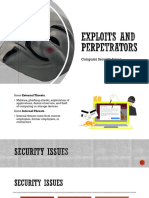0 ratings0% found this document useful (0 votes)
11 viewsOriginal 4
Original 4
Uploaded by
warwarThe document discusses securing sign-in processes by creating strong passwords, keeping passwords secure by not sharing them and updating them frequently, and moving away from passwords altogether by using more secure passwordless sign-in methods like biometrics or security keys.
Copyright:
© All Rights Reserved
Available Formats
Download as PDF, TXT or read online from Scribd
Original 4
Original 4
Uploaded by
warwar0 ratings0% found this document useful (0 votes)
11 views1 pageThe document discusses securing sign-in processes by creating strong passwords, keeping passwords secure by not sharing them and updating them frequently, and moving away from passwords altogether by using more secure passwordless sign-in methods like biometrics or security keys.
Copyright
© © All Rights Reserved
Available Formats
PDF, TXT or read online from Scribd
Share this document
Did you find this document useful?
Is this content inappropriate?
The document discusses securing sign-in processes by creating strong passwords, keeping passwords secure by not sharing them and updating them frequently, and moving away from passwords altogether by using more secure passwordless sign-in methods like biometrics or security keys.
Copyright:
© All Rights Reserved
Available Formats
Download as PDF, TXT or read online from Scribd
Download as pdf or txt
0 ratings0% found this document useful (0 votes)
11 views1 pageOriginal 4
Original 4
Uploaded by
warwarThe document discusses securing sign-in processes by creating strong passwords, keeping passwords secure by not sharing them and updating them frequently, and moving away from passwords altogether by using more secure passwordless sign-in methods like biometrics or security keys.
Copyright:
© All Rights Reserved
Available Formats
Download as PDF, TXT or read online from Scribd
Download as pdf or txt
You are on page 1of 1
Securing the
sign-in process
One of the most important ways to ensure the
safety of your online accounts is to keep your
sign-in process secure.
Follow this advice to help keep your accounts
out of the wrong hands:
1. Create strong passwords 2. Keep passwords secure
Hackers don’t break in; they sign-in. If you use Once you’ve created strong passwords that
passwords as part of your sign-in process, you’ll hackers can’t crack, you must keep them secure.
need to make sure they are as strong as possible. If they can’t break your passwords, criminals
Strong passwords are: will try to trick you into revealing them. To keep
your passwords as safe as possible, follow these
• At least 12 characters long (but 14 or more is guidelines:
better)
• Don’t share a password with anyone—not
• A combination of uppercase letters, even a friend or family member
lowercase letters, numbers, and symbols
• Never send a password by email,
• Not a word that can be found in a dictionary instant message, or any other means of
or the name of a person, character, product, communication that is not reliably secure
or organization
• Never re-use the same password—all your
• Significantly different from your previous passwords should be unique
passwords
• Update your passwords frequently
• Easy for you to remember but difficult for
others to guess • Always access websites using trusted links
• Don’t hesitate to change passwords
immediately on accounts you suspect may
have been compromised
3. Get rid of passwords altogether
Creating strong passwords and keeping them secure can be a lot of work, especially when you have multiple
passwords to remember and manage across all your accounts. But what if you didn’t have to manage passwords at
all? Passwordless sign-in methods like the Microsoft Authenticator App, physical security keys, and biometrics are
more secure than traditional passwords, which can be stolen, hacked, or guessed.
Learn more about Microsoft Security’s insights at
www.microsoft.com/security/business/cybersecurity-awareness.
Share more about cybersecurity best practices
©2022 Microsoft Corporation. All rights reserved. This document is provided “as-is.” Information and views expressed in this document, including URL and other internet
website references, may change without notice. You bear the risk of using it. This document does not provide you with any legal rights to any intellectual property in any
Microsoft product. You may copy and use this document for your internal reference purposes.
You might also like
- Mobile Repair TrainingDocument10 pagesMobile Repair Trainingwarwar75% (4)
- Vacuum Induction Furnace: Installation and Operating InstructionsDocument31 pagesVacuum Induction Furnace: Installation and Operating InstructionswarwarNo ratings yet
- EnglishDocument11 pagesEnglishnmsrapolloNo ratings yet
- Password ManagementDocument11 pagesPassword ManagementdwijeshbingumallaNo ratings yet
- Commom Threats Against PasswordDocument53 pagesCommom Threats Against Passwordnakeb16855No ratings yet
- Passwordmanagement 130523092759 Phpapp02Document53 pagesPasswordmanagement 130523092759 Phpapp02yassirNo ratings yet
- Cyber-Security Awareness News Letter ReadDocument5 pagesCyber-Security Awareness News Letter Readtanaka gwitiraNo ratings yet
- CST - Poster - ENGLISHDocument1 pageCST - Poster - ENGLISHPedro CarvajalNo ratings yet
- Passwords 3yqKr5DKQYuMYaoGKJ6yDocument7 pagesPasswords 3yqKr5DKQYuMYaoGKJ6yyaminelrustNo ratings yet
- CybersecurityDocument7 pagesCybersecurityapi-578362492No ratings yet
- Cyber SecurityDocument30 pagesCyber Securitykavyaluthra15No ratings yet
- IM-FB-Usernames-PasswordsDocument2 pagesIM-FB-Usernames-PasswordsAdekeye DamilolaNo ratings yet
- Everybody Password Cracking 101Document43 pagesEverybody Password Cracking 101kozzzakiiNo ratings yet
- 4-Protecting_Yourself_Online_Scams_FraudDocument29 pages4-Protecting_Yourself_Online_Scams_FraudzaidwwNo ratings yet
- CNIT 129S: Securing Web Applications: Updated 2-23-2022Document73 pagesCNIT 129S: Securing Web Applications: Updated 2-23-2022phamducnhonNo ratings yet
- Cyber Security Awareness Ver.1.0Document20 pagesCyber Security Awareness Ver.1.0syinata wk100% (2)
- Exp 4Document4 pagesExp 4morkheri32No ratings yet
- Password Power: How To Create A Strong Password Eight TipsDocument4 pagesPassword Power: How To Create A Strong Password Eight Tipsapi-525933683No ratings yet
- Unlocking Security: The Power of Random Password Generators: Strengthening Your Digital FortressDocument7 pagesUnlocking Security: The Power of Random Password Generators: Strengthening Your Digital Fortressnishwan2007No ratings yet
- Thor Teaches Study Guide CISSP Domain 5Document18 pagesThor Teaches Study Guide CISSP Domain 5babyNo ratings yet
- Online Security and PrivacyDocument18 pagesOnline Security and PrivacyAshish KumarNo ratings yet
- ch03 AuthDocument54 pagesch03 AuthNam NguyenNo ratings yet
- Cybersecurity Awareness Month 2024 Cyber 101 PPTDocument15 pagesCybersecurity Awareness Month 2024 Cyber 101 PPTvipavix725No ratings yet
- Passwords (1) CNIBDocument6 pagesPasswords (1) CNIByaminelrustNo ratings yet
- Lesson Presentation Keep It To YourselfDocument14 pagesLesson Presentation Keep It To YourselfRandy OrangeNo ratings yet
- Internet Safety Quiz - RezultatiDocument27 pagesInternet Safety Quiz - Rezultatiapi-590808640No ratings yet
- GEMS Parents and Students Cybersecurity Guide 2023Document11 pagesGEMS Parents and Students Cybersecurity Guide 2023enzo.zidi19No ratings yet
- W3-Module 003 Implementing Basic Security SystemDocument4 pagesW3-Module 003 Implementing Basic Security SystemDean LevyNo ratings yet
- Password Power: How To Create A Strong PasswordDocument2 pagesPassword Power: How To Create A Strong Passwordapi-525933683No ratings yet
- IT Security AwarenessDocument23 pagesIT Security Awarenessmaria 3691No ratings yet
- Bahagian B KPPDocument2 pagesBahagian B KPPearineNo ratings yet
- Password Power: How To Create A Strong Password Eight TipsDocument1 pagePassword Power: How To Create A Strong Password Eight Tipsapi-525172582No ratings yet
- 05-user-accessDocument53 pages05-user-accessikuetsushimaNo ratings yet
- Cybersecurity For Kids Volume 2Document16 pagesCybersecurity For Kids Volume 2Ammar HassanNo ratings yet
- PasswordDocument11 pagesPasswordCharmaine ClosaNo ratings yet
- Password Data Security-ENG (iSEC)Document9 pagesPassword Data Security-ENG (iSEC)Jhon Fredrick KeliatNo ratings yet
- Online Security Tips: Protect Yourself When You're Online!Document3 pagesOnline Security Tips: Protect Yourself When You're Online!Rohit SinghNo ratings yet
- Lecture3 AutheticationDocument28 pagesLecture3 Autheticationmakangara22No ratings yet
- Cloud GCP StorageDocument28 pagesCloud GCP StoragesnehaNo ratings yet
- 20 Ways To Stop Mobile AttacksDocument1 page20 Ways To Stop Mobile AttacksIngArnaldoParraNo ratings yet
- Cisco Mfa Password Security Infographic PDFDocument1 pageCisco Mfa Password Security Infographic PDFCharismatic ArslanNo ratings yet
- Computer / Internet Security: West Haven Public LibraryDocument39 pagesComputer / Internet Security: West Haven Public LibraryTamika LeeNo ratings yet
- Al102 CompileDocument17 pagesAl102 CompilespiderrysNo ratings yet
- Chapter 2Document15 pagesChapter 2w.com.ael99No ratings yet
- Slidesgo Enhancing Cybersecurity Awareness A Comprehensive Training Program 202405270250341yTBDocument20 pagesSlidesgo Enhancing Cybersecurity Awareness A Comprehensive Training Program 202405270250341yTBzintepestNo ratings yet
- Stay Cyber Resilient While WFH-Tip SheetDocument1 pageStay Cyber Resilient While WFH-Tip SheetmoNo ratings yet
- Mail For Cyber SecurityDocument2 pagesMail For Cyber Securityexecutive design2No ratings yet
- Online Dos and DontsDocument3 pagesOnline Dos and DontsAnna Mariel TumalonNo ratings yet
- Cyber Security For Kids 2.1Document19 pagesCyber Security For Kids 2.1Angel CabralesNo ratings yet
- Cyber Security For Kids 2.1Document19 pagesCyber Security For Kids 2.1Angel CabralesNo ratings yet
- Lecture3 AutheticationDocument28 pagesLecture3 Autheticationmakangara22No ratings yet
- rules for setting secure passwordsDocument2 pagesrules for setting secure passwordsLê Lan anhNo ratings yet
- 5 Tips How To Stay Safe OnlineDocument1 page5 Tips How To Stay Safe OnlineRebekah MagawayNo ratings yet
- Unit 3 Host SecurityDocument34 pagesUnit 3 Host SecurityGeleta SafoyiNo ratings yet
- Passwordless - Authentication - WP FinalDocument8 pagesPasswordless - Authentication - WP FinalyawahabNo ratings yet
- Week 2 Online Safety and Security PresentationDocument8 pagesWeek 2 Online Safety and Security PresentationShiba MahesvaraNo ratings yet
- Sysadmin Magazine April 2023Document18 pagesSysadmin Magazine April 2023sylvain roseNo ratings yet
- Chapter6 Authentication and Key AgreementDocument64 pagesChapter6 Authentication and Key Agreementmed kudoNo ratings yet
- Introduction of Password: Here Is An Overview of Some of The Different Type of Password Commonly Used by PeopleDocument15 pagesIntroduction of Password: Here Is An Overview of Some of The Different Type of Password Commonly Used by Peopleparthkalsariya216No ratings yet
- Password Security: How Passwords Are Cracked..Document1 pagePassword Security: How Passwords Are Cracked..Denny TobingNo ratings yet
- infomation security training (1)Document13 pagesinfomation security training (1)namanmali46No ratings yet
- Guidebook For Your Digital World: How To Avoid the Scammers and Pickpockets on Your Digital JourneyFrom EverandGuidebook For Your Digital World: How To Avoid the Scammers and Pickpockets on Your Digital JourneyNo ratings yet
- WMB X1 User Manual English 1Document20 pagesWMB X1 User Manual English 1warwarNo ratings yet
- Free E-Books: Free Download Engineering Ebooks - PDF - PPT - Lecture NotesDocument20 pagesFree E-Books: Free Download Engineering Ebooks - PDF - PPT - Lecture NoteswarwarNo ratings yet
- Expansion of Soft Drinks Unit-Kelpalm DatDocument6 pagesExpansion of Soft Drinks Unit-Kelpalm DatwarwarNo ratings yet
- MN s7-Cps-pb 76 TeDocument225 pagesMN s7-Cps-pb 76 TewarwarNo ratings yet
- Design and Simulation of Induction HeatingDocument3 pagesDesign and Simulation of Induction HeatingHadi BarakNo ratings yet
- 737 123 PDFDocument31 pages737 123 PDFwarwarNo ratings yet
- 06,250 (-1), 260 To 240 RS-232 Communications Wiring Diagram: TechnotesDocument1 page06,250 (-1), 260 To 240 RS-232 Communications Wiring Diagram: TechnoteswarwarNo ratings yet
- PLC Connection GuideDocument1,163 pagesPLC Connection GuidewarwarNo ratings yet
- UNDP TR HSHandbook - 2009 PDFDocument79 pagesUNDP TR HSHandbook - 2009 PDFLumbiwe MakunkaNo ratings yet
- Study Guide 4 Disaster Risk Reduction and Management Concepts Part 2Document5 pagesStudy Guide 4 Disaster Risk Reduction and Management Concepts Part 2Mark Raven PoyaoanNo ratings yet
- Lecture 1 Introduction To The Management of Information SecurityDocument47 pagesLecture 1 Introduction To The Management of Information SecurityJatin ChaudharyNo ratings yet
- FBI LHM On Moss Request For Office of Censorship Records Feb 1963Document2 pagesFBI LHM On Moss Request For Office of Censorship Records Feb 1963Patrick EddingtonNo ratings yet
- PR1 Introduction To CNS FinalDocument6 pagesPR1 Introduction To CNS FinalprafullaNo ratings yet
- IISP Knowledge Framework v1.0 - 2017-AugustDocument195 pagesIISP Knowledge Framework v1.0 - 2017-AugustwaleedNo ratings yet
- 14 Cyber Security Awareness 1Document9 pages14 Cyber Security Awareness 1Michelle EsternonNo ratings yet
- paper christian natalDocument4 pagespaper christian natalAgus PurwadiNo ratings yet
- The Us National Security StrategyDocument8 pagesThe Us National Security StrategyAlex WRRNo ratings yet
- Information Security: Prepared By: Waqas Ahmad ButtDocument292 pagesInformation Security: Prepared By: Waqas Ahmad ButtAbu Huraira100% (1)
- Basic Concepts and PrinciplesDocument28 pagesBasic Concepts and PrinciplesPixie LaterNo ratings yet
- Enterprise Security Risk Management - A Foundation of Enterprise Risk - ASIS GSX Presentation 2018-09Document26 pagesEnterprise Security Risk Management - A Foundation of Enterprise Risk - ASIS GSX Presentation 2018-09Bruce ROBERTSONNo ratings yet
- GURPS Lite Combat Expansion FinalDocument2 pagesGURPS Lite Combat Expansion FinalAndré PozziNo ratings yet
- STP BPOPS ACCOMPLISHMENT REPORT 2nd SemDocument2 pagesSTP BPOPS ACCOMPLISHMENT REPORT 2nd SemFrancis LayagNo ratings yet
- Level of Competency of Security Personnel in Bomb Threat: Basis For Program Formulation - Mark Anthony T. NazaroDocument18 pagesLevel of Competency of Security Personnel in Bomb Threat: Basis For Program Formulation - Mark Anthony T. NazaroMatt LocardNo ratings yet
- Lunajesus LuigicasestudyanswersDocument7 pagesLunajesus Luigicasestudyanswersapi-645969479No ratings yet
- Cybersecurity Best PracticesDocument4 pagesCybersecurity Best PracticesImam KusroniNo ratings yet
- Ite4001 Network-And-Information-security Eth 1.1 47 Ite4001Document2 pagesIte4001 Network-And-Information-security Eth 1.1 47 Ite4001Vivek GopalshettyNo ratings yet
- China Police SystemDocument2 pagesChina Police SystemNheil Patrick PunongbayanNo ratings yet
- Pres 1 PPSXDocument5 pagesPres 1 PPSXSofía Succar MurraNo ratings yet
- Oman Presentation MDS 19th JuneDocument173 pagesOman Presentation MDS 19th Juneshiv kumarNo ratings yet
- JEWERS DOORS LTD - Corporate Brochure (CURRENT)Document8 pagesJEWERS DOORS LTD - Corporate Brochure (CURRENT)Syed RaziuddinNo ratings yet
- Health Care Security Checklist Internal AuditDocument3 pagesHealth Care Security Checklist Internal AuditNisha BhimsariaNo ratings yet
- 01 Introduction To Information SecurityDocument16 pages01 Introduction To Information Securityanon_200163716No ratings yet
- Book I: Weapon Contamination EnvironmentDocument84 pagesBook I: Weapon Contamination EnvironmentInternational Committee of the Red Cross100% (3)
- Computer Security and SafetyDocument17 pagesComputer Security and Safetyjaylouisedale.badaNo ratings yet
- Script For As2Document2 pagesScript For As2Mia ApdohanNo ratings yet
- Week 1: Overview: DR Emiliano de CristofaroDocument30 pagesWeek 1: Overview: DR Emiliano de CristofaroJimmy LyNo ratings yet
- Question BankDocument5 pagesQuestion BankNavneeth GnlNo ratings yet
- The Chernobyl Disaster PresentationDocument16 pagesThe Chernobyl Disaster PresentationVarshi100% (1)



































































































